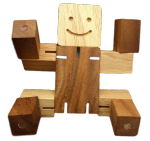Teaching Child to Tell Time

The following provides the steps you can use in teaching child to tell time. It is best taught with a toy clock as this helps the child to visualise and practice telling time.
1. Explain to them that the short hand shows the hours, the long hand shows the minutes and there are exactly sixty minutes in one hour.
2. Start with the minute hand. Tell them that each time it goes around is one hour.
3. Explain that every time the minute hand goes one round, the hour hand will move to the next number signifying an hour has passed.
4. Place both the hour and minute hand at 12. Turn the minute hand one round and let the child know that one hour has passed and it is now 1 o'clock. Have your child practice turning the minute hand one round at a time and stop at 12. Point to the hour hand and mentioned that it is now 2 o'clock. Practice this for a while.
5. Next, you can teach the concept of half hour ie when the minute hand moves half a circle. Start from 12 and stop at 6 and say "it is now half-past two" .
6. Introduce your child to counting by fives. This will help teaching child to tell time by five minute intervals. Move the minute hands of the clock, counting the minutes by fives as the hand pass each number until you get to 15. Stop at each quarter hour and say the time.
The whole process of teaching child to tell time may take days or even weeks depending on each child. To enhance the process of learning to tell time, below are some activities you can use to make telling time an enjoyable session.
Teaching child to tell time through activities
1. Provide a worksheet with a large circle. Ask the students to place the numerals inside the circle to make a clock face. According to the ability of the group, you may wish to place some marks on the circle to facilitate spacing of the numbers.
2. Provide a worksheet with clocks that have no hands on them. Underneath each clock, write a time in the "o'clock" form. Have the students draw in the minute and hour hands to show the correct time.
3. Play a telling time game.
Write times to the hour from 1 o'clock to 12 oclock on index cards and a number from 1 to 12 on a tagboard square. Place the numbers 1-12 in a large circle to form a clockface.
Children sit around the clock. Give 12 children each a time card to keep facedown. Two volunteers, one taller than the other, stand in the center of the clock.
Ask:
Who should be the minute hand? Why? (the taller child because the minute hand is the long hand.)
Where should the taller child point to show 1 oclock? (to 12)
Where should the shorter child point? (to 1)
Children take turns holding up their index cards. Students tell where the children representing the hands should point to show that time. Repeat the activity until all children have a turn to show the time.
4. Make a clock out of a paper plate that shows the time. Mark times on the clock that are significant in your child’s day, such as mealtime and bedtime. Repeatedly show this clock face at the time of the event.
You can also find worksheets on teaching child to tell time here.


New! Comments
Have your say about what you just read! Leave us a comment in the box below.